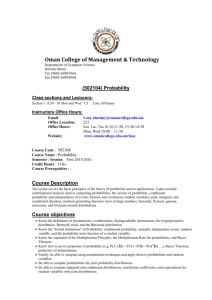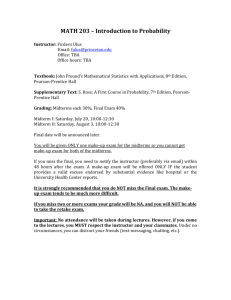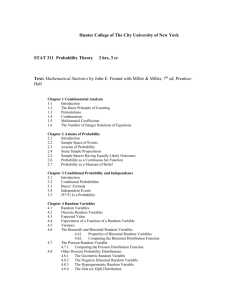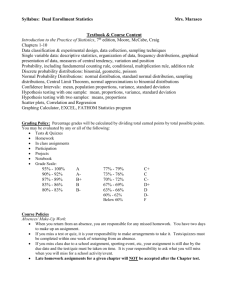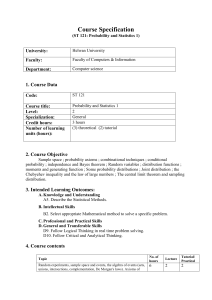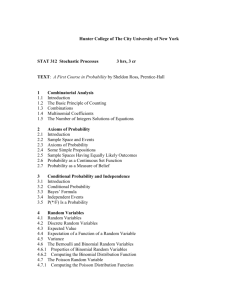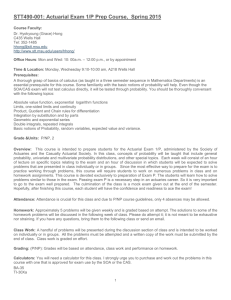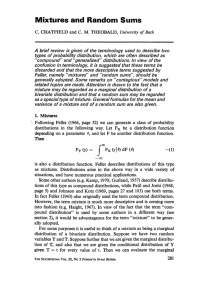MATH 382
advertisement
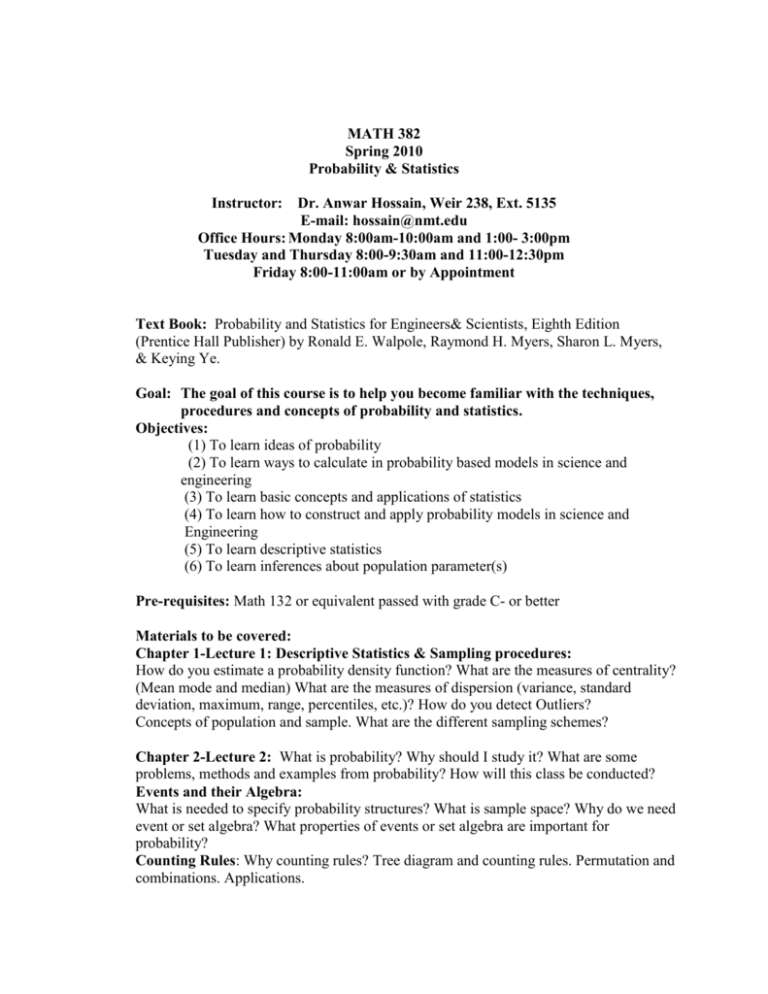
MATH 382 Spring 2010 Probability & Statistics Instructor: Dr. Anwar Hossain, Weir 238, Ext. 5135 E-mail: hossain@nmt.edu Office Hours: Monday 8:00am-10:00am and 1:00- 3:00pm Tuesday and Thursday 8:00-9:30am and 11:00-12:30pm Friday 8:00-11:00am or by Appointment Text Book: Probability and Statistics for Engineers& Scientists, Eighth Edition (Prentice Hall Publisher) by Ronald E. Walpole, Raymond H. Myers, Sharon L. Myers, & Keying Ye. Goal: The goal of this course is to help you become familiar with the techniques, procedures and concepts of probability and statistics. Objectives: (1) To learn ideas of probability (2) To learn ways to calculate in probability based models in science and engineering (3) To learn basic concepts and applications of statistics (4) To learn how to construct and apply probability models in science and Engineering (5) To learn descriptive statistics (6) To learn inferences about population parameter(s) Pre-requisites: Math 132 or equivalent passed with grade C- or better Materials to be covered: Chapter 1-Lecture 1: Descriptive Statistics & Sampling procedures: How do you estimate a probability density function? What are the measures of centrality? (Mean mode and median) What are the measures of dispersion (variance, standard deviation, maximum, range, percentiles, etc.)? How do you detect Outliers? Concepts of population and sample. What are the different sampling schemes? Chapter 2-Lecture 2: What is probability? Why should I study it? What are some problems, methods and examples from probability? How will this class be conducted? Events and their Algebra: What is needed to specify probability structures? What is sample space? Why do we need event or set algebra? What properties of events or set algebra are important for probability? Counting Rules: Why counting rules? Tree diagram and counting rules. Permutation and combinations. Applications. Chapter 2-Lectures 3: Probability Definitions and Rules: What do we need to specify probability function on events? What is a probability function? How are probabilities assigned? What are some consequences of these axioms? Additive Rules Chapter 2-Lecture 4: Conditional probability What is conditional probability? Why is it useful in probability assignments? Why are tree diagrams useful? What are some applications of conditioning? Chapter 2-Independence and Rules of Probability: What is independence? Why is it useful? How does it contrast with mutual exclusion? What are the useful rules of probability? Multiplicative Rules. Chapter 2-Lecture 5: Bayes Theorem or Bayes Rule: What is the theorem of total probability? What is Bayes theorem? To what kinds of problems does it apply? How are tree diagrams useful here? Applications of probability and Bayes Rule. Chapter 3-Lecture 6: Random variables and Probability distributions: What are random variables? How is their behavior described? What are distribution and probability functions? What are their properties? Chapter 4-Lecture 7: Expected Values :What are the mean, variance and standard deviation of a discrete random variable? What are the useful properties? Chapter 4-Lecture 8: Chebyshev’s Theorem: Chapter 5-Lecture 9: Some Discrete Probability Distributions: Uniform, Binomial and Multinomial distributions: What are the assumptions of uniform, Binomial and multinomial distributions? What are the mean and variances of the distributions? Chapter 5-Lecture 10: Hypergeometric, Negative Binomial and Geometric Distributions: What is the Negative Binomial distribution? When is it applied? What are the mean and variances of the above distributions? Chapter 5-Lecture 11: Poisson distribution & the poisson Process: What is the Poisson distribution? When is it applied? What are the mean and variances of the above distribution? Chapter 3-Lecture 12: Continuous Random variables: What is a continuous Random variable? How is it described? What is a probability density function? What are the measures of continuous random variables? Chapter 6- Lecture 13: Some continuous distributions: What is uniform distribution? What is the exponential distribution? When are they used? What is a gamma random variable and what are its properties? Chapter 6-Lecture 14: Normal Random Variable: What is a standard normal density? What are the mean and variance of a normal distribution? How are probabilities calculated for normal random variables? What are some applications of the Normal Distribution? What are ways to check Normality? What is a Q-Q plot and how is it used? Normal approximation to the Binomial. Chapter 6-Lecture 15: Gamma & Exponential distributions: Chapter 6-Lecture 16: Chi-Squared, Lognormal Distribution & Weibull Distributions: Chapter 3-Lecture 17: Joint random variables: How is the behavior of several random variables described? What are the joint distribution functions and joint probability density functions? How are they related and how are probabilities calculated? What are the conditional probability functions? What are the marginal probability densities? What are the conditional probability densities? Chapter 7-Lecture 18: Functions of random variables: How can we treat functions of random variables? What is the method of distribution functions? What is the method of transformation? Why is the sum of the random variables important? What are the limiting properties of probabilities? Chapter 4-Lecture 19: Expected Values and properties: How are the expected values of functions of several random variables defined? What is the covariance between two random variables? What is correlation coefficient? What is a conditional expected value. What are some important properties of conditional expectations? Chapter 7-Lecture 20: Moment generating functions: How are moments generating functions defined for continuous case? What are some common moment generating functions? Chapter 8-Lecture 21: Sampling distributions: What is the Central limit Theorems? How is it applied? T-distribution & F-distribution Chapter 9 -Lecture 22: Estimation and hypothesis testing: Point and interval estimates for large and small samples. Paired observations. Estimating proportion. Maximum likelihood estimation. Chapter 10-Lecture 23: one and two sample tests: General concepts of hypotheses. One and two tailed tests. Concept of two types of errors. Concepts of P-value. Test of hypotheses for mean(s) for large and small samples. Inference of dependence data (Paried t-tests (correlated data)). Inferences using two independent population means. Chapter 10-Lecture 24: Inference for population proportion(s): Confidence interval for population proportion and test of hypothesis for proportion P. Inferences for two population proportions. Chapter 11-Lecture 25: Linear regression & Correlation: What is a least squares method? Some discussion and assumptions. Correlation analysis and residual analysis. How do you predicted a value using least square technique? Chapter 13-Lecture 26: ANOVA What is analysis of variance? How do you make an inference for more that two population means? COURSE POLICY: You are encouraged to seek help from the instructor. Your course grade will be determined on the basis of combined scores from Homework, in class tests and final exams. In order to make up any assignment, a valid excuse should be documented. The instructor decides if an excuse is a valid one. Exams: There will be two in class tests which will be announced one week ahead of time. Homework: All homework is due at the beginning of the lecture (the day it's assigned). Two lowest scores will be dropped. Grading is based on the percentage of total points earned (the individual tests, homework etc. are not assigned a letter grade). Distribution of points: Homework In class Tests Final Total 25% 45% 30% 100% Grading Scale (tentative): A: 90-100%; B: 80-89; C: 70-79; D: 60-69; F: < 60 The instructor reserves the right to change any part of this syllabus as he sees fit. YOU ARE RESPONSIBLE FOR ALL MATERIAL ASSIGNED IN THE TEXT AND ALL THE MATERIAL IN CLASS. REGULAR CLASS ATTENDANCE IS STRONGLY RECOMMENDED. THE COURSE IS A CUMULATIVE COURSE- FOR THIS REASON DO NOT FALL BEHIND AND ALWAYS DO THE HOMEWORK! MATH 382 HOMEWORK PROBLEMS FOR SPRING 2010 HW# 1: HW#2: HW#3: HW#4: HW# 5: HW#6: HW#7: HW# 8: HW#9: HW#10: HW#11: HW#12 HW#13: HW#14: HW#15: HW#16: HW#17: 1.19, 2.14, 2.17, 2.31, 2.54, 2.65 2.80, 2.81, 2.86, 2.92, 2.102, 2.108 3.3, 3.5, 3.11, 3.13, 3.24, 3.25 5.9, 5.16, 5.23, 5.45, 5.55, 5.70 3.7, 3.9, 3.14, 3.18, 3.21, 3.27 6.5, 6.7, 6.9, 6.24, 6.33, 6.37 6.41, 6.42, 6.44, 6.48, 6.52, 6.56 3.38, 3.40, 3.41, 3.44, 3.47, 3.59 7.4, 7.7, 7.10, 7.12, 7.15, 7.18 4.4, 4.19, 4.23, 4.46, 4.47, 4.67 8.15, 8.22, 8.26, 8.43, 8.57 9.2, 9.5, 9.7, 9.17, 9.41, 9.45 9.51, 9.55, 9.66, 9.70, 9.71, 9.73 9.81, 9.82, 9.83, 9.96, 9.97 10.5, 10.11, 10.22, 10.28, 10.36, 10.53 10.58, 10.63, 10.71, 10.82, 10.92 11.2, 11.7, 11.18, 11.23, 11.52


